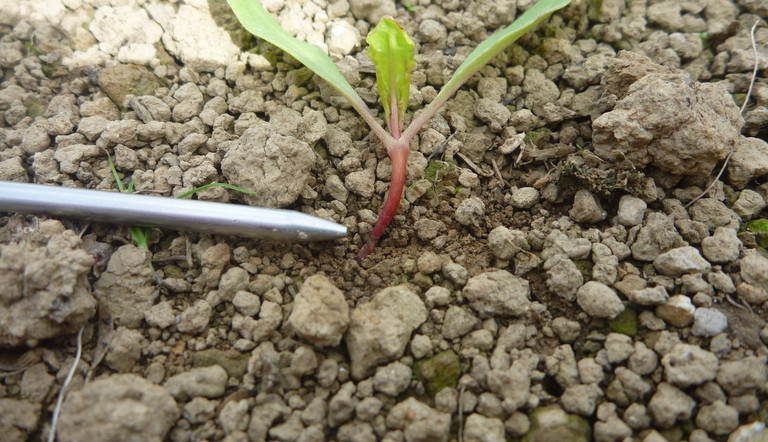
ADAMA’s Mavrik® balances safety and efficacy

20/7/21 - Mavrik Aquaflow Insecticide (Mavrik) from ADAMA New Zealand has successfully achieved the critical balance between efficacy against pests and avoiding harm to beneficial insects and users. Trials have shown that Mavrik, the latest addition to ADAMA’s beet protection toolkit, delivers control of serious pests Nysius and cutworm in fodder beet seedlings.
Importantly, it does so without the adverse impacts of current industry standard products.
Elisabeth Johnston, ADAMA New Zealand Marketing Manager, says the unique chemistry has significant benefits. “Not all synthetic pyrethroids (SPs) are created equal. Tau-fluvalinate, the active in Mavrik, is proven to be much safer for beneficial insects, parasitoids, predators, and pollinators than other SPs available in New Zealand. Additionally, it is entirely crop safe when applied with approved ADAMA products at the sensitive cotyledon stage.”
ADAMA is also confident that Mavrik will have registration for forage brassicas in time for the beginning of the new season. This will give farmers and contractors a welcome, effective, user-friendly alternative to organophosphates (OPs).
Preventing Nysius damage
Elisabeth says it is at the post-emergence stage when beet seedlings are particularly at risk from Nysius and cutworm. “This is where Mavrik comes into its own. There can be huge damage to plants if Nysius is not well controlled.” Unchecked, Nysius feeding damage to the base of the plants can destroy a high percentage of the crop, massively impacting growers relying on their high-value beet crop.
Nysius are found where vegetation is sparse and sunlight falls directly on the ground, making seedlings especially susceptible. They thrive under the hot, dry conditions many regions have experienced over the last two growing seasons. Adult Nysius hide under clods or debris on the ground when the temperature begins to fall in the evening and become active in the morning when the temperature rises.
Elisabeth says application of Mavrik is recommended for times when Nysius are active as temperatures rise during the day; applying at seedling stage only, as a first post-emergence spray. “Apply at first sign of pest presence and ensure good coverage of plants and surrounding soil. A repeat application can be made after 14 days if required.”
Recent ADAMA beet trials showed Mavrik provided a high degree of Nysius control and reduction of plant damage in trials following one or two applications.
Dealing with cutworm effectively
Similarly, cutworm trials showed Mavrik prevented significant plant damage.
After hatching, young cutworm caterpillars forage on leaves until they are about one third grown. Larger cutworm caterpillars lie curled up 25-50 mm below the soil surface during the day and emerge at night to feed. Larger cutworm caterpillars are also the most damaging, cutting seedlings off at their base.
Applications of Mavrik can control small cutworm caterpillars, preventing them growing to a more damaging size. For larger cutworm, spray applications should be made in the evening or night when the caterpillars emerge to feed.
Gentle to beneficials
Mavrik works by affecting the nervous systems of target insects after direct contact or ingestion. While these pests are overcome, the impact on key beneficials is minimal, allowing them to continue their good work as the crops develop.
Beneficials can be exposed to pesticides in a number of ways. These include; direct contact with spray droplets during application, contact with spray residue on the plant or soil after application, and by the consumption of pesticide-contaminated prey.
Beneficials such as hoverflies and lacewings have a vital role in protecting beet and other nearby crops. Hoverfly larvae feed on aphids of all kinds while the adult is an important pollinator. Lacewings are broad spectrum predators, effective against pests including aphids and psyllids. “Effectively, they’re the farmers’ and growers’ free workers”, Elisabeth says. “Mavrik is also the leading bee-safe SP.” When applied during non-foraging periods, applications will not interfere with the activity of honey-bees once spray has dried.
Powerful, safe and flexible toolbox for beet
ADAMA New Zealand has an extensive beet protection toolbox with Mavrik being the latest of three products launched recently. The two others are Custodia® and Goltix® Gold. Custodia is a beet foliar fungicide, which not only supports greener, healthier and more vigorous leaves, but offers greater grazing flexibility. Goltix Gold is a powerful herbicide, featuring a unique formulation with proven efficacy in controlling hard-to-kill weeds such as fathen and wireweed.
Mavrik is crop safe when applied to beet seedlings at cotyledon stage in a tank-mixture with ADAMA beet herbicides such as Goltix Gold, Ethosat® Herbicide, Rifle® and other commonly used pesticides.